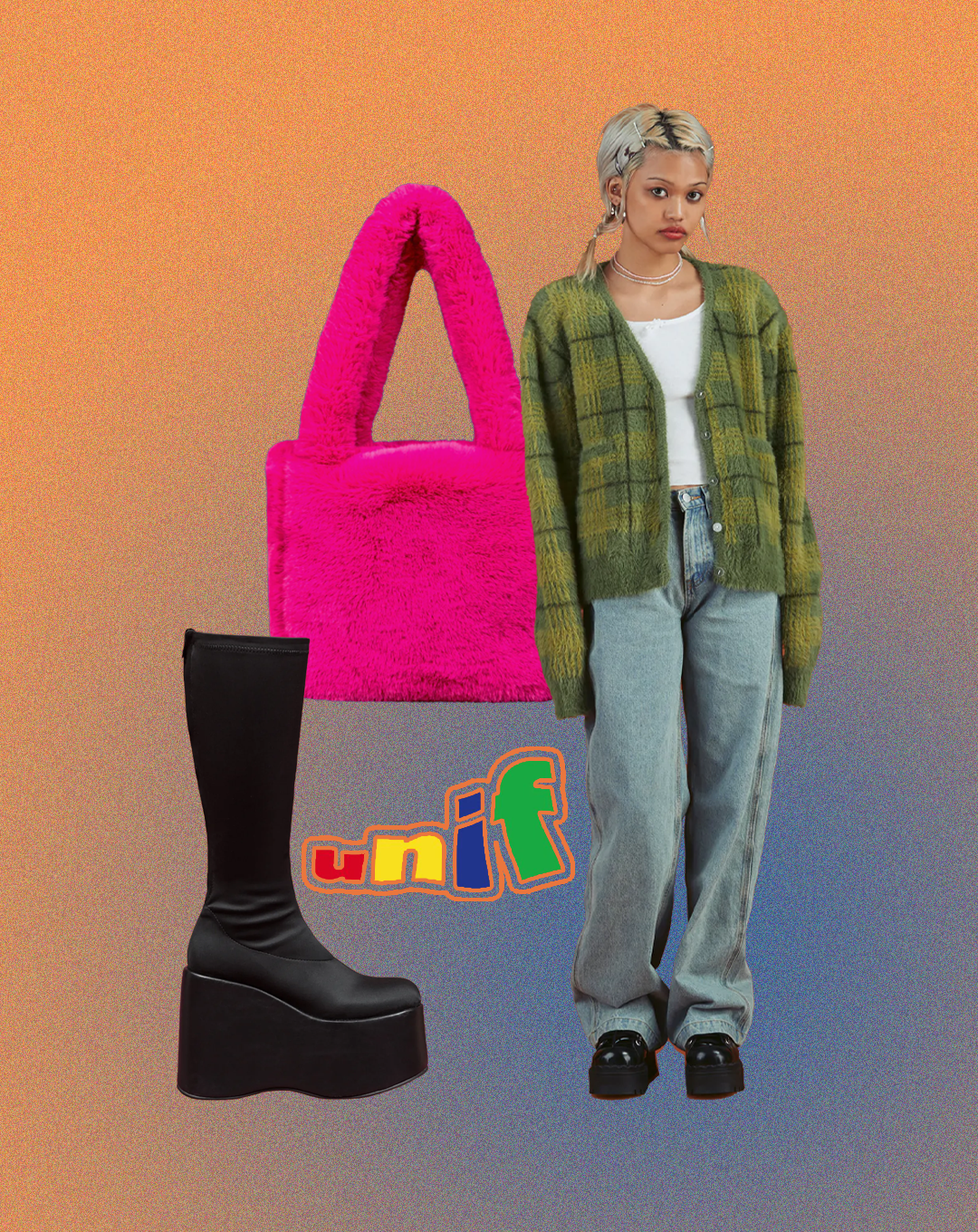Did We Forget About UNIF? The Inevitable Death of Trend Focused Fashion Brands
From its collections of holographic platforms with ragged soles to richly blue cardigans with sunflower details, UNIF was one of the biggest brands to affirm the nineties and noughties fashion comeback in the late 2010s. The independent, Los Angeles family brand, UNIF, polished what Y2K could be.
UNIF’s exceptional popularity led to constant “notify me!” blurbs at the bottom of their to-die-for products, as their shoes and sweaters were constantly sold out. Specifically, the Dot Mary Janes, Bliss Boots, Astera Sweater, and more were an online battle royale for the it-teens in training to try and own an exclusive UNIF piece. The LA brand was worn by all of the it-girls social media and fashion has graced us with: Emma Chamberlain, Enya Umanzor, Salem Mitchell, Internet Girl, and Guvmanian. These girls were secret weapons that left buyers amazed by clothing basics like cropped sweaters and pleated skirts.
Customers were evidently enthralled by UNIF less than ten years ago. As new collections dropped, consumers would take to social media, constantly reposting selfies of them in their new UNIF products. Profiles were made in dedication to the loyal fans who filled their rooms up with UNIF decor. So, how did this generation’s roaring 20’s become so obviously separated from the brand? Similar brands of this age have loved and used Y2K as motivation, so why has UNIF been shunned? It’s not as if we all woke up and chose to get over Y2K style: A walk around any popular city will prove noughties style is still alive and kicking.
What changed? The same site with pieces that were constantly unavailable is now easily accessible. The campaigns, the anxiousness to get a pair of whatever before your sizes are no longer clickable – gone. The reshares, the hype, lost like a bobby pin or a threaded needle. UNIF isn’t exactly deceased, but its popularity has definitely taken a backseat. As high-school superlatives go, it’s no longer the queen bee of it-girl fashion.
Bow your heads, and toss the white roses upon this casket because fashion truly does die. In order for a brand to remain on top, it must fulfil many customer needs:. That can be price, quality, sizing, irony, or boasting rights. UNIF used to appeal to the latter as, if you had the new UNIF pieces, you were automatically the girl to sit with as it was the primary recognition of similar interests. You’re wearing the tunnel sweater? It must be a no-brainer that you love Solange and watch ‘Skins.’
Y2K at UNIF’s time of reign was much more scarce as there weren’t that many brands to rely on for these kinds of styles. Sure, there was I.AM.GIA and O-Mighty, but these brands became difficult to stay popular because of their constant dupes alongside their distasteful contributions to fast fashion. Now, as Y2K is one of the biggest leading fashion trends, the scarcity that UNIF thrived off of has been outshined by variety. The Y2K trend isn’t as definite as when it started and has now become the overall umbrella term for the subcultures that lie within it. The popularity of TikTok and Instagram has contributed to the expanded horizons. 90s Harajuku fashion reappeared in 2020 amongst the birthing of Gothcore, Barbiecore, Footballcore, minimalism, and its opposing evil twin, maximalism. These cores have made the 90s and 2000s romanticization wider than just a pair of baggy pants— Y2K is now too vague a term to title your sense of style, the particular subcultures within it guarantee originality.
“Once consumers feel they can begin to guess the next collection’s possibilities, an ick has been developed.”
An Instagram page known as ‘UNIF Copied’ completely changed the trajectory of the brand with blatant evidence of the designs UNIF stole stitch by stitch. The UNIF Daith Mary Janes were a copy of the Espirit platforms, and the best-selling Dot Mary Janes were a remake of the identical designs from a brand called Trend One. These were brands with clothing that could be found in thrift shops today, items that wouldn’t— and shouldn’t— cost a customer more than fifty dollars. The only clear-cut difference are the prices UNIF has assigned to their replicas.
The newer brands of the 2020s (Heaven by Marc Jacobs, Praying, OGBFF, etc.) have established a fresh relationship with Gen Z. They’ve produced surprising and ironic designs that keep them on their chrome-polished toes for what’s to come next. Their spontaneity ensures a loyal fanbase, because once consumers feel they can begin to guess the next collection’s possibilities, an ick has been developed. The infatuation dies slowly as it becomes painstakingly clear how predictable a product is - an issue reminiscent of UNIF.
But is any brand truly safe? Even the stores achieving great successes right now can’t ensure longevity. Especially if the leading concept is pivoted by this Y2K catalyst. The difficulty of trends is that they hold everything except loyalty: The same label could be founded on a trend— its existence skyrocketing. Consumers can feel a deep sigh of relief thinking, “Yes! This shop came right on time.” But once more options and more brands become visible, and that itch of exploring another trend happens, the rodeo of capitalism continues. We move on.
UNIF’s lost following while nineties and noughties styles rise in popularity represent how fashion is an open casket. The real horror of UNIF’s downfall is knowing this company won’t be the last. Remember: Fashion is only capitalism dressed up in sparkles and styled shoots.
Words: JoliAmour DuBose-Morris


